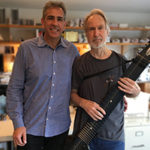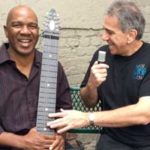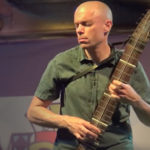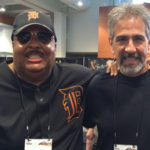Brilliant inventor of the Chapman “Stick” tells FBPO the whole story of the instrument’s origin, players and what’s next (lots of photos, too!)
Exclusive interview with FBPO’s Jon Liebman
November 29, 2010
A former jazz guitarist, Emmett Chapman is the founder of Stick Enterprises and inventor of the Chapman “Stick.”
FBPO: Tell me about your musical upbringing. Didn’t you have stints with the accordion and ukulele?
EC: I played accordion in church and ukulele in high school before moving on to guitar and vocals. I worked my way through college at UCLA playing clubs on Ventura Boulevard in the San Fernando Valley. My mother was a very entertaining vocalist/guitarist and played many of the nightclubs on Chicago’s Rush Street, singing in several languages.
FBPO: What possessed you to develop the Stick?
EC: At the time the Stick was first conceived, around 1969, I was a guitarist and had come under the spell of Jimi Hendrix. Before that, I’d been listening to and learning from jazz guitarists and pianists for about ten years. My jazz discipline broke when I discovered two-handed tapping on my guitar, releasing a flood of creative technique. I called it “Free Hands” in my lesson book of 1974 and referred to it as “open architecture.”
FBPO: Tell us, in layman’s terms, what a “Stick” is.
EC: It’s a new musical instrument in the family of electric guitars and bass guitars. It’s capable of full orchestral execution of a song, an improvisation or a basic musical idea. Melodies can be played expressively, using many finger effects. The bass line is driving and resonant and the chords are polyphonic and endlessly variable. The Stick can also produce sounds that are polyrhythmic, with counterpoint popping out of every sector.
FBPO: So … should Stick players be considered bass players?
EC: Sometimes. We have a “Dual Bass Reciprocal” tuning especially for that role, with two bass groups, one in descending 4ths and the other in ascending 5ths, held together by a common low B bass string in the middle. Mostly, however, the Stick in all its tunings is a mirror for one’s own musical style, cultural genre and even one’s own personality. The instrument can go in any direction, from keyboards to lead guitar to drum-like percussion.
 |
 |
 |
|
Dark bamboo
|
Mahogony 10-string
|
Maple NS
|
FBPO: When I think of high-profile Stick players, I always think of Alphonso Johnson and Tony Levin. Who else is on that list?
EC: Nick Beggs of the London area is another well-known bassist who plays a lot of Stick in the studio and on live tours. Also, Don Schiff of Rocket Scientist in Northridge, an active studio session man. Other prominent players who play in the more complete solo style include Bob Culbertson of Northern California, Greg Howard and Rob Martino, both of Virginia, Jim Lampi of the UK, Guillermo Cides of Spain, Virna Splendore of Italy, Irene Orleansky of Israel, Boris Bazurov of Russia, Mauricio Sotelo of Cabezas de Cera in Mexico, Steve Adelson of Long Island, New York, and Larry Tuttle and Kevin Keith, both in the San Fernando Valley. There are many other excellent and experienced Stick artists around the world and the range of styles and genres is enormous.
FBPO: How quickly did it take for the Stick to catch on? Can you identify a “tipping point” when its popularity had become widespread?
EC: Still waiting for that tipping point! Up to now it has been slow and steady growth with solid musical results and lots of hard work.
FBPO: How many versions of the Stick are available today?
EC: There are six basic Stick models in long 36-inch bass guitar and short guitar scale lengths, all with 8, 10 or 12 strings. These include the standard 10-string Stick, the wider 12-string Grand Stick, the 8-string Stick Bass and the NS/Stick, which is the only one with a bass guitar body and tapered neck. There’s also the shorter 10-string Alto Stick and 12-string Stick Guitar. All these Stick model names are also registered U.S. and European Community trademarks.
We have several recommended Stick type tunings for all the above models, as well as any possible custom tuning on any of the models. The Stick is in concept a “blank slate” and the pickups and hardware will accommodate any gauge string at any position, from lowest bass to highest melody. Thus we have no need to charge extra for custom tunings.
 |
 |
 |
|
Paduak 12-string
|
Rosewood 10-string
|
Tarara 10-string
|
FBPO: What lies ahead for Stick Enterprises?
EC: A radically new Stick model I’ve been designing and prototyping. Lots of continuing Stick cultural events including “Stick Night” concerts seminars, college lectures, feature articles in major music magazines and, last but not least, my own planned videotaped performances.
FBPO: What’s keeping you busiest these days?
EC: It’s always production and repairs, but also R&D, purchasing of goods and services, detailed customer service – including lots of daily email – and special projects in collaboration with other Stick players.
FBPO: What do you like to do that’s not musically oriented?
EC: Science, health and medicine, astrology, tennis and writing essays.







